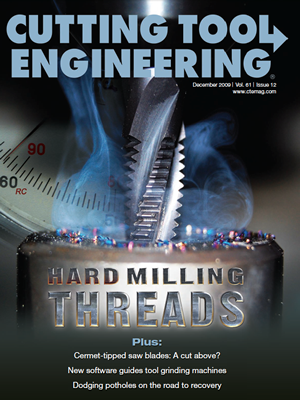Every machine shop has to decide whether to make cutters or buy them. A similar decision exists for regrinding cutting tools in-house or paying a company to perform the service.
Another consideration is tool coatings: what coatings to use, when to apply coated tools and whether a tool is recoated after resharpening.
A small percentage of toolmakers grind and produce most of their own cutting tools from solid-carbide blanks. In addition to producing their own standard cutters, these toolmakers must design specials for specific jobs.
In operation, tool life is targeted for a specific number of minutes, and then all cutters are resharpened. Shops that grind their own new cutters also resharpen them because the grinding equipment can perform both tasks. However, some shops report lower tool life from resharpened cutters.
To maintain the production of high-quality parts, new cutters are often used for finishing, and resharpened cutters are relegated to roughing. Two shops that grind their own claim they are able to produce a more accurate cutter than one that’s purchased.
When milling titanium alloys at less than 70 sfm, I do not recommend applying coated tools. This slow milling speed applies mostly to roughing with cobalt tools. If it is important to coat a new cutter, then it is equally important to use the same coating after resharpening the tool. Recoating presents a logistical problem because most shops are not capable of coating tools. The usual practice is to overnight cutters to a coating company.
Some relatively small-diameter cutters require a long reach into a deep section of a part and the tools flex too much to make efficient cuts. The usual solution is to use a tapered-shank cutter for more rigidity, but the cost is quite high. A lower-cost solution is to create a “telescope” of shrink-fit toolholders to maintain the needed rigidity to extend the cutters. The cost is kept low because standard shrink-fit holders are used and only the tool tip needs replacement when worn.
Many cutters are dynamically balanced in their toolholders before going to the machine tool. Balancing might employ drilling holes in the holder or adding screws to it to ensure proper balance.
Shrink-fit toolholders are my choice for milling titanium alloys. Any cutter that runs faster than 8,000 rpm must be balanced, but I prefer balancing toolholder/cutter assemblies for all spindle speeds to extend spindle life. One unbalanced cutter run at a high speed can quickly damage a $50,000 spindle and shut a machine down for 2 weeks while waiting for a replacement spindle.
It is also easier to manage the balancing process if all cutters are handled in the same manner. Balancing should be done dynamically using equipment that rotates the holder/cutter assembly because static balancing is not adequate. CTE
About the Author: The late Edward F. Rossman, Ph.D., was an associate technical fellow in manufacturing R&D with Boeing Integrated Defense Systems, Seattle. Rossman’s Shop Operations column is adapted from information in his book, “Creating and Maintaining a World-Class Machine Shop,” published by Industrial Press Inc., New York. The publisher can be reached by calling (212) 889-6330 or visiting www.industrialpress.com.
Related Glossary Terms
- alloys
alloys
Substances having metallic properties and being composed of two or more chemical elements of which at least one is a metal.
- coated tools
coated tools
Carbide and high-speed-steel tools coated with thin layers of aluminum oxide, titanium carbide, titanium nitride, hafnium nitride or other compounds. Coating improves a tool’s resistance to wear, allows higher machining speeds and imparts better finishes. See CVD, chemical vapor deposition; PVD, physical vapor deposition.
- gang cutting ( milling)
gang cutting ( milling)
Machining with several cutters mounted on a single arbor, generally for simultaneous cutting.
- grinding
grinding
Machining operation in which material is removed from the workpiece by a powered abrasive wheel, stone, belt, paste, sheet, compound, slurry, etc. Takes various forms: surface grinding (creates flat and/or squared surfaces); cylindrical grinding (for external cylindrical and tapered shapes, fillets, undercuts, etc.); centerless grinding; chamfering; thread and form grinding; tool and cutter grinding; offhand grinding; lapping and polishing (grinding with extremely fine grits to create ultrasmooth surfaces); honing; and disc grinding.
- milling
milling
Machining operation in which metal or other material is removed by applying power to a rotating cutter. In vertical milling, the cutting tool is mounted vertically on the spindle. In horizontal milling, the cutting tool is mounted horizontally, either directly on the spindle or on an arbor. Horizontal milling is further broken down into conventional milling, where the cutter rotates opposite the direction of feed, or “up” into the workpiece; and climb milling, where the cutter rotates in the direction of feed, or “down” into the workpiece. Milling operations include plane or surface milling, endmilling, facemilling, angle milling, form milling and profiling.


